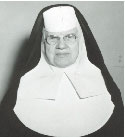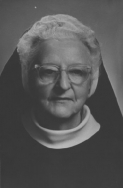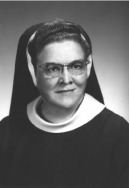Catholic Tradition
Mount Mercy University’s foundation, strengthened by the Sisters of Mercy’s five Critical Concerns, guides students in exploring an education that reaches far beyond the classroom. Students of all faiths are encouraged to join our faith-based community, leading to intellectual development, self-reflection, and spiritual growth.
Our Catholic Identity
The university strives to be a community that demonstrates the highest standards of Catholic intellectual tradition, welcoming students of all faiths to engage in an education that fosters intellectual development, self-reflection, and spiritual growth.
Guided by core values of truth, respect, responsibility, excellence, and service, the university encourages the pursuit of knowledge for the common good. Through service learning and volunteer opportunities, students are invited to apply these values in addressing the Critical Concerns identified by the Sisters of Mercy, as well as the values reflected in Catholic Social Teaching. This commitment reflects Mount Mercy's dedication to integrating faith with action, nurturing compassionate leaders ready to serve a global community.
Mount Mercy is sponsored by the Institute of the Sisters of Mercy of the Americas, through the Conference for Mercy Higher Education. As a Mercy institution, we carry out our charge to continue the Catholic intellectual tradition. As such we respectfully abide by the Conference for Mercy Higher Education’s statement on Catholic Identity and Mercy Charism.
Catholic Social Teaching
Catholic Social Teaching is a rich tradition of thought and action that guides Catholics in applying the Gospel message to the challenges of modern society. Rooted in the dignity of every person and the call to love one’s neighbor, Catholic Social Teaching emphasizes principles such as the common good, solidarity, subsidiarity, and the preferential option for the poor. These teachings, drawn from scripture and Church tradition, inspire individuals and communities to work for justice, peace, and the flourishing of all people.
Mercy Values & the Sisters of Mercy's Critical Concerns
The Mercy values and the Sisters of Mercy's Critical Concerns are deeply rooted in Catholic Social Teaching and the Gospel. Founded by Catherine McAuley, the Sisters of Mercy have historically focused on serving those in need, emphasizing social justice and compassion. Their Critical Concerns—Earth, immigration, nonviolence, anti-racism, and women—emerge from a commitment to uphold human dignity and promote the common good, as emphasized in Catholic Social Teaching. At Mount Mercy University, these values are woven into the fabric of the institution, guiding educational programs and community initiatives that reflect a steadfast dedication to faith-inspired action and societal transformation.
Our History
The Sisters of Mercy established Mount Mercy Junior College in 1928 with the purpose of filling a need—the need to unite people with opportunity through high quality, values-based education.
Mount Mercy flourished as a junior college and continued to have success as a four-year institution. Over the years, Mount Mercy has added new programs and curriculum which were reflective of the mission and values of the original institution. Today, Mount Mercy’s available course offerings are tailored to meet the needs of those who live and work around campus in the same spirit of our founders.
The Sisters of Mercy purchased Mound Farm and Greene mansion in 1907 after leasing the property in 1906, a move that would lay the groundwork for Mount Mercy Junior College, which was opened by the Sisters on September 9, 1928. Students who enrolled in the junior college received a low cost Catholic education from the Sisters, who worked tirelessly to provide a rich education in the name of Catherine McAuley. For the next 30 years, Mount Mercy thrived as a two-year institution for women.
It wasn’t until the 1950s that the Sisters’ vision of a four year college came to fruition. They decided that the community surrounding Mount Mercy would benefit from a baccalaureate institution in the heart of Cedar Rapids, and after receiving accreditation from The Higher Learning Commission of the North Central Association of Colleges and Schools, Mount Mercy became a four year college in 1960.
The 1960s proved to be a decade of further change for the students, faculty, and staff of Mount Mercy. Regina Hall was built in 1965, providing the first on-campus housing since students first began residence in Warde Hall. Soon after, Mount Mercy opened its doors to both male and female students by officially becoming co-educational in 1969.
Throughout the next 30 years, Mount Mercy met the physical demands of a growing student population. Donnelly Center was opened in 1975, followed by Hennessey Recreation Center (1985), Busse Center (1993), Lundy Commons (1995) and Betty Cherry Heritage Hall (1996). Students utilized these spaces for classes, course work, athletic endeavors, co-curricular activities, and for socializing – and with these new facilities came increased opportunities. By 1997, students had the option to write for the Mount Mercy Times, to participate in a robust athletic program with 13 NAIA varsity sports, and adult students were welcomed into the ADVANCE program, a partnership with Kirkwood Community College.
Many years had passed since Mount Mercy was a junior college, but the feeling of imminent change was much the same in 2006 as it was in 1956. The College had recently completed construction on Andreas House (2001), a residence suite for upperclassmen, and Basile Hall (2003), adding additional classroom and laboratory space for business, biology, chemistry, physics and other programs. On August 23, 2010, the institution was re-designated to Mount Mercy University, making Mount Mercy the only Mercy university in the state of Iowa and one of only four in the Midwest. Construction began on the university Center in the heart of Mount Mercy’s main campus in 2010 and the facility opened in 2011 offering the campus community a beautiful space to socialize and study.
In 2012, the university announced plans to renovate the former army and navy training center at 1650 Matterhorn Drive NE into the Mount Mercy University CRST International Graduate Center. The center began hosting classes in 2013 and is home to Mount Mercy’s low-cost Olson Marriage and Family Therapy Clinic as well as five graduate programs: Master of Business Administration, Master of Science in Nursing, Master of Arts in Education, Master of Strategic Leadership, and Master of Arts in Marriage and Family Therapy. June 2013 marked a special announcement for the university’s athletics—the purchase of 22 acres adjacent to the main campus on 17th Street NE would become Mount Mercy’s first outdoor athletic complex. Demolition began on the property in April 2014. The facility, completed in September 2017, is home to softball, baseball, an all-purpose track, multipurpose practice field, and a soccer field. For the first time in the institution’s history, outdoor athletes have a home field advantage. Former president Laurie M. Hamen, JD, led the university from February 2014 to June 2020 with the same strength, courage, and vision as her predecessors. Dr. Robert Beatty joined Mount Mercy on July 1, 2020, as the institution's president. On September 9, 2020 Dr. Beatty resigned from his position and Dr. Tim Laurent was announced as the Interim President. Currently, Dr. Todd A. Olson is serving as the president of Mount Mercy University, starting his presidency on July 21, 2021.
The Sisters of Mercy
In 1827, Catherine McAuley in Dublin, Ireland, began caring for women and children in need at the House of Mercy. Drawing on resources entrusted to her and her deep commitment to prayer and service, she provided safe housing, education for those who were poor or uneducated, and visited the ill. In 1831, Catherine formally committed her life to this mission by founding the Sisters of Mercy.
The community grew rapidly as the Sisters responded to urgent needs in their neighborhoods. By the time of Catherine’s death in 1841, Mercy communities had been established throughout Ireland and England. In 1843, the Sisters of Mercy arrived in the United States, accompanying Irish immigrants and responding to the needs of growing communities by establishing schools, hospitals, and other works of mercy. By 1856, the Sisters of Mercy had expanded into Scotland, Newfoundland, Australia, and New Zealand, continuing their mission wherever there was greatest need.
The first Sisters of Mercy came to Cedar Rapids from the Iowa towns of Davenport and Independence, where communities had been established in 1869 by sisters from Chicago. Three Sisters, Mary Isadore O’Connor, Mary Boniface Daly, and Mary Gertrude McCullough, arrived in Cedar Rapids on July 22, 1875, and four more came from Davenport two weeks later. They were responding to a request for teachers for the new St. Joseph Academy, a boarding school for girls and a parochial day school. The only transportation to the town was by steamboat or rail.
St. Joseph Academy was to be housed in a new building near the commercial center of the city. When the Sisters arrived the building was not only unfurnished, but unfinished! Upon viewing the building, one sister is said to have exclaimed, “The windows are not in!” Another playfully replied, “Well, we won’t have to wash any windows today.”
Eager to get the building ready for the school year, the sisters rolled up their sleeves to help the carpenters, laying floors and installing windows. In addition to the academy, the building would also serve as the convent and novitiate for the next 30 years.
As early as 1894, the Sisters opened their first hospital, which was located in the rural Iowa community of Anamosa. In 1900, because the only hospital in Cedar Rapids was consistently filled beyond its capacity, the sisters opened a 15-bed hospital in a converted house. Response from the citizens was overwhelming and by 1903, after much scrambling for funds, the sisters moved Mercy Hospital to a brand new building with 100 patient beds and the most advanced technology of the day. A year later they welcomed their first class of students to the Mercy School of Nursing. They later added schools of Medical Technology and Radiology.
By 1906, their convent, novitiate and school were all bursting at the seams and the search began for a larger site. Eventually, the sisters located and leased the Judge Greene mansion, which was then beyond Cedar Rapids' city limits. Over the years, the property had at times been home to three shady horse thieves, an alleged counterfeiter, and finally, a Supreme Court judge. Judge George Greene was responsible for having the mansion built and was the first legally recognized owner of the property, the others being considered squatters.
The mansion had been vacant for about 10 years, used only as an occasional shelter by hunters, with the ballroom being used for grain storage. After signing a lease, the sisters once again rolled up their sleeves to lovingly prepare the mansion for their motherhouse, novitiate and the fall opening of their girl’s boarding school, Sacred Heart Academy. St. Joseph Academy continued to operate in its original location as a day school.
The farsighted leadership of the Cedar Rapids Sisters of Mercy elected to buy the Greene property in 1907. Future years saw remarkable growth in Sacred Heart Academy boarding school for girls, as it became Mount Mercy Academy in 1924, a junior college in 1928, a four-year college in 1960, and went co-ed in 1969. In 2010, the early vision of the sisters was realized when Mount Mercy became a university.
Through the years, the sisters divested themselves from their involvement with all the rural hospitals. Day-to-day operations/management of Mercy Medical Center, Mount Mercy University and the Catherine McAuley Center have been turned over to each organization’s Board of Trustees. A true continuity of the Mercy mission is maintained by having sisters serving on each board at all times. An Executive Director for Mission and Ministry, who is liaison for all three sponsored works, also ensures that Mercy values will remain the primary focus at each of the sponsored ministries.
Sister Presidents
 |
Sister Mary Ildephonse Holland | 1928–1933, 1946–1961 Sister Mary Ildephonse formally entered the Sisters of Mercy on April 15, 1904 and is notable for her two terms of service as the college’s president. Considered the “Foundress of Mount Mercy College,” Ildephonse had past educational experience as a teacher on most K-12 levels, worked as the Bursar and Mother Superior for the Sisters, and served as a college instructor and campus business manager. Among her many achievements are the construction of Warde Hall, the opening of Mount Mercy Junior College, the bachelor’s degree designation by North Central, and the all-important accreditation for the college. |
 |
Sister Mary Cornelia Burke | 1933–1939 Sister Burke's decision to expand the college’s course offerings to include nursing can be directly associated with her position as Superintendent of Mercy Hospital, Cedar Rapids. While appointed as president of the college, Sister Mary Cornelia simultaneously served as Major Superior of the Sisters of Mercy. Burke also extended Mount Mercy’s student teaching opportunities. Her significant work in growing the campus’ education and nursing programs remains her legacy to the college. |
 |
Sister Mary Maura Marron | 1939–1946 Sister Mary Maura’s tenure with the campus is recognized for its tremendous work within the Sisters of Mercy. Marron established the Sisters’ first, formal novitiate and directed the revision of their constitutions. For the college, she initiated studies that would eventually lead to the North Central Association accreditation and established a building fund, clearly seeing the need for future structures in the quest to become a four-year institution. |
 |
Sister Mary Agnes Hennessey | 1961–1977 During her fifteen years as college president, Hennessey led the campus through monumental change. McAuley Library opened in 1962, shortly followed by the second dormitory, Regina Hall, in 1965. The Greene Mansion, once the home of the Sisters of Mercy, was demolished, and in 1968, the Sisters transferred legal authority to a Board of Trustees. Student enrollment tripled, and the college became co-educational in 1969. Faculty numbers expanded, reflecting a varied curriculum. |